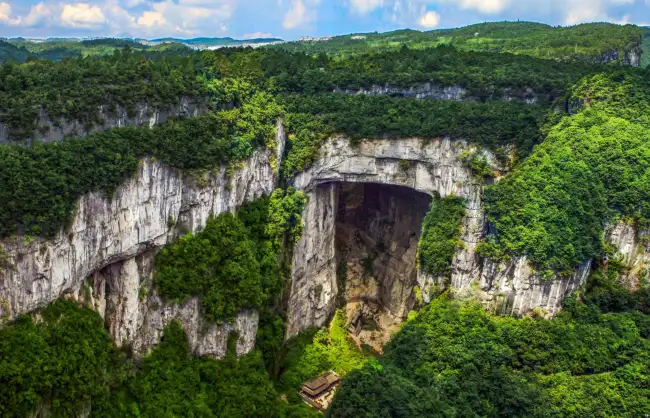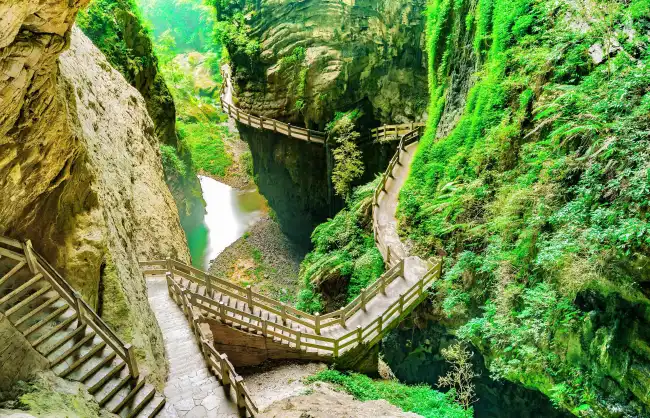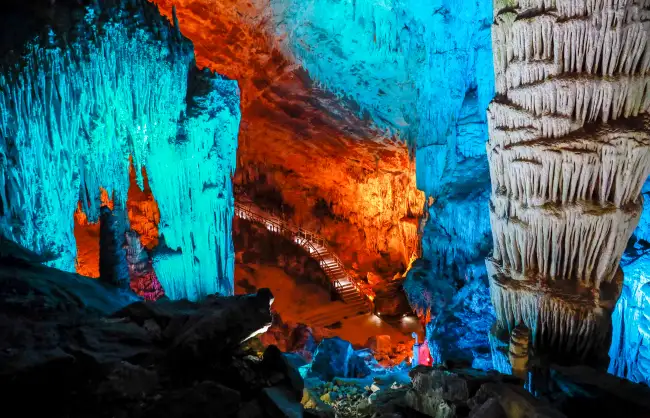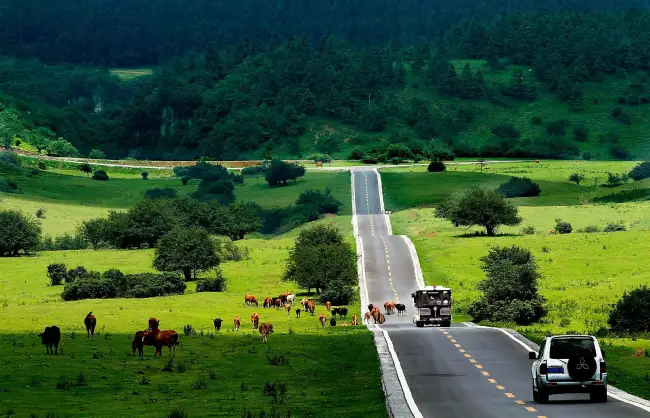Wulong Karst National Geology Park, about 150 kilometers from downtown Chongqing, was declared a UNESCO World Heritage Site in 2007. It houses some of the most stunning karst landscape in South China, such as naturally-formed bridges and sinkholes, verdant gorges, emerald rivers and cascading waterfalls. The surreal scenery is the very reason for swarms of tourists coming here during their travel in Chongqing.
Fast Facts of Wulong Karst Geological Park
- Location: 32, Yinxing Avenue, Wulong District, Chongqing City
- Recommended Time to Go: Spring (March –May), autumn (September – November)
- Time Needed: 1-2days
- Highlights: Supersized natural bridge group, dazzling underground karst cave, naturally-formed karst fissure gorges and sinkholes, alpine grassland…
- Suited to: Photographers, nature lovers, families
What to See in China Wulong Karst Scenic Area
1. Three Natural Bridges – Marvel at the Nature’s Uncanny Workmanship
The Three Natural Bridges is the most highlighted spot in China Wulong Karst Geological Park. It is known worldwide for being the largest natural bridge group in Asia, and is composed of Heavenly Dragon (Tianlong) Bridge, Green Dragon (Qinglong) Bridge and Black Dragon (Heilong) Bridge. The three bridges stretch across the lush, deep valley and form two giant sinkholes – Tianlong Pit and Eagle Pit – in between.

Tianlong Bridge, Qinglong Bridge, Heilong Bridge
You need to take the sightseeing elevator down to the valley floor, and start the exploration of the Three Natural Bridges there. Walk along the path against the cliffs and the Tianlong Bridge will soon come into view. The bridge is 235 meters above your head. It is like the front gate of the scenic area, spanning across vertical cliffs.
Continue the hiking and you will reach the Qinglong Bridge. It has the largest vertical drop among the three, stretching over the 280-meter-deep valley.
The last one is the Heilong Bridge. Due to the low light there, this bridge looks like a black dragon lurking on the top, and hence the name. Here you will see four streams of water trickling down from the arch of the Heilong Bridge, just like pearl curtains hanging under the bridge.
Tianlong Pit, Eagle Pit
Between the Tianlong and Qinglong bridges is the Tianlong Pit. It is about the size of two football fields and is enclosed by steep cliffs. It is where the thrilling fight scene of the “Transformer 4: Age of Extinction” was filmed. There is also the Tianfu Posthouse. This quaint courtyard was originally built in 619 in the midst of shrubs against the cliffs and was an important setting of the “Curse of the Golden Flower” – a Chinese costume movie directed by Zhang Yimou.
The Eagle Pit lies between the Qinglong and Heilong bridges. Looking up from the sinkhole, you will be surprised to find that the surrounding cliffs bear a striking resemblance to a giant eagle spreading its wings, hence its name.
Opening Hours:
08:00 – 17:00 (last entry at 16:30)
Ticket Price:
March – October: CNY 125
November – February: CNY 95
Note: The ticket price includes the sightseeing elevator and the round-trip travel bus between the Tourist Center of Wulong Karst National Park and the Three Natural Bridges.
2. Longshuixia Fissure Gorge – Feel the Heartbeat of the Earth
As an important part of the Wulong Karst Scenic Area, Longshuixia Gorge is praised as “the most beautiful fissure on earth”. It stretches 5 kilometers in length, with depths ranging from 200 to 500 meters. The valley presents a typical karst landscape formed by a violent orogenic movement hundreds of thousands of years ago.
The starting point of Longshuixia is 80 meters below ground level and can be accessed by a sightseeing elevator. Once you get out of the elevator, you will be greeted by a waterfall falling over a high and broad cliff. Then go down the winding plank road along the underground river, and you will enjoy every minute exploring the wonderful karst scenery consisting of cascading waterfalls, limpid streams, vertical cliffs, and lush primitive plants.

Opening Hours:
08:00 – 17:00 (last entry at 16:30)
Ticket Price:
March – October: CNY 105
November – February: CNY 85
Note: The ticket price includes the sightseeing elevator and the round-trip travel bus between the Tourist Center of Wulong Karst National Park and Longshuixia Gorge.
3. Furong Cave – Explore the Mysterious Underground World of Stalactites
Furong Cave is like a dazzling underground art palace nestled by the turbulent Furong River inside Wulong Karst Geopark. It is the only cave in China that has been listed as one of the World Nature Heritage Sites, and houses almost all kinds of sediments formed more than 1.2 million years ago.
The Furong Cave spreads across 37,000 square meters. Inside the karst cave are a great variety of stalactites, stalagmites, stone pillars, stone curtains and stone flowers, all glistening in colorful lights. Some are like pines and cypresses, some like waterfalls, some like Buddha statues, some like pagodas… Just let your imagination fly and feast your eyes on a real-life fairytale world.

Opening Hours:
08:00 – 17:00 (last entry at 16:30)
Ticket Price:
March – October: CNY 150
November – February: CNY 135
Note: The ticket price includes the round-trip cableway between the Tourist Center of Wulong Karst National Park and the Furong Cave.
4. Fairy Mountain – Enjoy a Relaxing Time at the Natural Retreat
After exploring the bizarre Wulong karst landscape, you might want to have some leisurely time to get refreshed. The Fairy Mountain can be a lovely destination for you. The forest park is like a wonderful natural oxygen bar in the suburban area of Chongqing. It owns vast alpine grassland, verdant hills, seas of forests and wide snowfields, and is therefore hailed as the “No. 1 Pasture in Southern China”.
Besides the refreshing natural scenery, tourists can seek more fun by taking part in diverse recreational activities, including horse riding, archery, go-kart riding, grass skiing and paragliding.
Opening Hours:
08:00 – 17:00 (last entry at 16:30)
Ticket Price:
| Entrance Ticket | CNY 50 |
| Sightseeing Train | CNY 25 |

Best Time to Visit Wulong Karst National Geology Park
It is highly recommended tourists pay a visit to Chongqing Wulong Karst Geological Park in spring (March – May) and autumn (September – November). The Chongqing weather is neither too hot nor too cold during this time, which is very comfortable for outdoor excursions. Meanwhile, gorges inside the scenic area are clothes in lush trees and shrubs, especially in spring, different kinds of flowers are in full bloom, adding beautiful splashes of color to the valley.
How to Get to Wulong Karst Scenic Area from Chongqing
- By Train:
For visitors who intend to set out on a Wulong karst day tour, taking a train is the most convenient way. There are over 10 trains running between Chongqing North Railway Station and Wulong every day with the earliest train leaving at 08:06, and you will reach Wulong in around 2 hours.
Upon arrival at Wulong Railway Station, take the elevator down to the basement to board a direct bus to the Tourist Center of Wulong Karst National Geology Park. The bus ride takes about 40 minutes and costs CNY 10 per person.
- By Bus:
Visitors can also take a long-distance bus from Chongqing to Wulong Karst Geopark. There are frequent buses leaving Sigongli Transport Hub for Wulong from 07:30 to 19:40. Tourists will reach Wulong in about 4.5 hours and the bus fare costs CNY 36 per person. Upon arrival, transfer to a bus to Fairy Town (Xiannu Zhen) and you will get to the Tourist Center in around 40 minutes.
More Famous UNESCO-Listed Karst Sites in South China
- Stone Forest in Kunming: Known as the “museum of the world’s karst landforms, Stone Forest gathers a wealth of towering limestone pillars in the shape of swords, columns, pagodas, mushrooms…
- Libo Karst in Guizhou: Libo karst is known worldwide as the “emerald on the earth’s belt”, featuring cone-shaped peak clusters, primitive karst forests, green rivers, cascading waterfalls, and underground caves.
- Guilin Karst: The winding Li River is like a jade belt flowing through boundless karst hills in Guilin and Yangshuo. There are also plentiful underground river systems, forming a great many karst caves of stalactites and stalagmite
- Shibing Karst in Guizhou: It presents the unique dolomite karst landscape and presents the most beautiful scenery at Yuntai Mountain, located in the north of Shibing County.
- Jinfoshan Karst in Chongqing: Jinfoshan Mountain has experienced multiple orogenic movements and finally formed a unique landscape called Karst Table Mountain, with relatively flat peaks but nearly vertical cliffs.
- Huanjiang Karst in Guangxi: Huanjiang karst is widely known for being the largest, best preserved, and the only surviving karst forest ecosystem at its latitude. It well reflects the landform transition from highland regions gradually to low-hilly areas.
If you want to have a tailor-made China tour itinerary to Wulong Karst Geological Park, please feel free to contact us. We are willing to help you customize your trip!
Best Chongqing tour packages with Wulong Karst Geology Park









